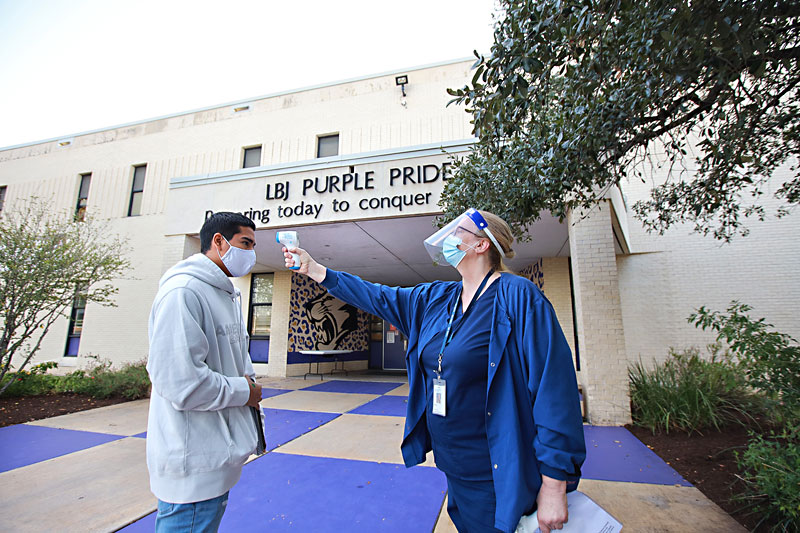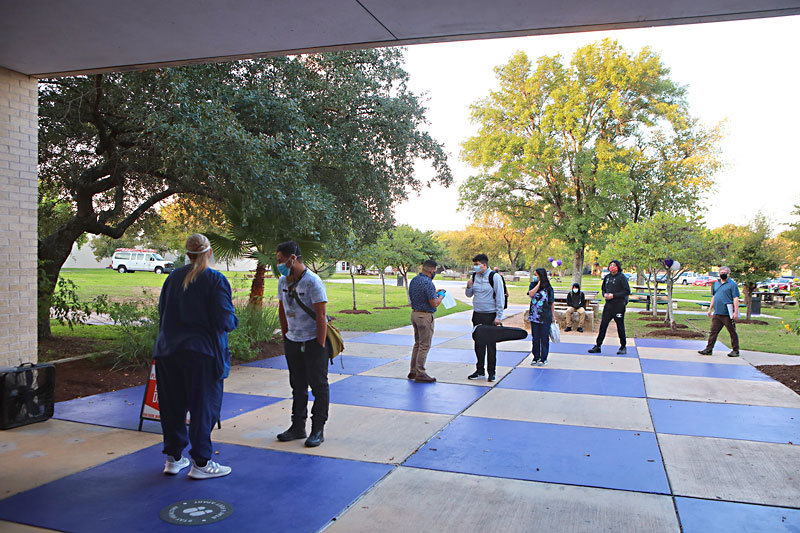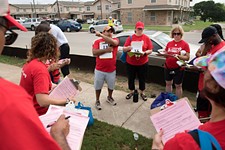AISD Students Can Learn From Home. Teachers Have Fewer Options.
Big mess on campus
By Clara Ence Morse, Fri., Oct. 9, 2020
When Tania Tasneem first learned she had to return to campus this fall, she tried to put the news out of her mind. She had to – virtual class was about to start. So she closed the news article, which, for her and many fellow teachers, was the first confirmation that returning would be mandatory – not a notice from the Austin school district – and got to work.
Tasneem would be required to return to her classroom at Kealing Middle School on Monday, Oct. 5, less than three weeks after reading that article. But she went through her classes, teaching her newly digitized Earth science curriculum to 13-year-olds over Zoom, for two days. She put on a good face and put aside her worries about her co-workers, her students, her job, and her health. Then she logged into a Thursday staff meeting and broke down crying while trying to form her questions about returning to campus. Her principal had also not known about the policy before learning through the media earlier that week.
When English teacher Chloe Cardinale shared an article about the return with co-workers at Austin ISD's Liberal Arts and Sciences Academy magnet high school, many thought it could not be true. It seemed "unbelievable," she said, after a summer consumed with preparation for online learning; after an eleventh hour delay – until after Labor Day – of the start of the school year; after hours of professional development to adapt to Zoom and BLEND and online pedagogy; after two weeks of non-disastrous remote learning in September; and after surveys showed that only a third of AISD students would choose to return to campus, that teachers would be given three weeks notice that they must return for the first day of in-person learning.
But it was true.
The Texas Education Agency's COVID-19 guidelines require all school districts to give parents the option to send students to class in person for part of the fall. Although AISD will be limiting capacity on its campuses through Nov. 2, at least some – AISD is prioritizing the youngest, special education, and newcomer students – must return to campus for the district to receive its state funding. The district also hopes to increase enrollment after a decline of more than 5,000 students for the fall semester, with pre-K and kindergarten being especially impacted. That represents more than $50 million in lost attendance-based state funding – a devastating blow to a district already shaken by the fiscal impact of the pandemic.
Publicly, AISD has portrayed its return to campus as an orderly, individualized, student-centered approach. Some teachers have a very different story to tell; in interviews with the Chronicle, 11 teachers across the district described a muddled, messy process, which seemed in constant flux.
All of these teachers described "absolutely no" guidance on returning to campus before last week, except through rumors and the media. Some did not receive specific information about their campus protocols and logistics until Friday, Oct. 2. Several said they'd had nightmares or panic attacks about the return, supplanting the usual first-week-of-school anxiety.
"Part of what's so frustrating is that we still really don't know what to expect," math teacher Andrew Stepek said in an interview a week before school began. "It's very tough not to know what ... my job is going to look like a week from now, or in two or three weeks from now."
How would things work?
Jenna Martin works at Kealing as a social studies teacher and an instructional coach, and specializes in educational leadership. The worst part of this fall for her, besides the lack of sleep, has been the inability to give input on the return and the sense that her voice is not valued.
"We were surveyed once, and it was on the eve of our contracts [in May]. Then after that, we have been not surveyed, not asked for creative solutions," Martin said. "When I as a parent get five surveys, and me as a teacher get zero, that's bullshit. That is not a democratic transparent institution."
In a press statement, AISD mentioned three teacher input meetings, and a task force which included teachers, at the beginning of summer. Although the reopening task force that worked throughout the summer contained no teachers, Superintendent Stephanie Elizalde announced on Sept. 28 that she had assembled a committee of 40 teachers, whom she spoke with last Wednesday and again this Tuesday.
Lack of communication makes logistical challenges more difficult. For instance, many middle and high schools are following the "pod" model, in which each classroom holds one small group of students, who attend their different classes on Zoom, while a teacher monitors them and teaches their classes virtually. Questions were raised: Will audio work with up to 10 people on Zoom calls in the same room? Will students be provided headphones? Who will aid students with technical problems? How will bathroom breaks work? What if students take their masks off? What about lunch?
Spotty communication from the district also heightened tensions about AISD's strict accommodations policy. Initially, exceptions from the mandatory return policy were only available for teachers who were themselves pregnant, immunocompromised, or of advancing age. "Third parties," including children, spouses, and parents, did not qualify – teachers who share a home with immunocompromised people were still expected to teach on campus.
One teacher, who asked to remain anonymous due to fear of repercussions from the district, told the Chronicle he had requested accommodations due to a partner with asthma and been denied. (He returned to campus on Monday.) "It has made me really angry," he said. "The unit that we're going to start on October 5 in my class is ethics ... I'm teaching my students different ideas about how to make ethical choices, and I think that they're going to see some counterexamples to that with this idea of pushing everybody back [to campus]. It doesn't necessarily feel like the ethical choice."
This teacher said the situation had made him seriously consider pursuing other career options. "It's hard thinking about different directions when I'm in a job that I love," he said. "But at the same time, I'm feeling much less certain that I can trust the leadership in the district to make safe choices."
By October 5, teachers had requested 998 accommodations, of which 713 had been granted, 65 were pending, 219 were "inactive," and one had been denied, out of the district's 5,500+ classroom teachers. The Education Austin union announced that 850 teachers had committed to stay home and teach virtually on Monday, regardless of the policy.
Education Austin met with AISD leaders throughout last week about expanding options for teachers who didn't feel safe returning to campus. After these talks, Elizalde said she plans to give principals more flexibility in handling the return to their campuses, and that teachers who did not take a sick day or show up on Monday will be handled on a case-by-case basis. "The district is continuing to work with Education Austin and we are looking forward to their proposal that would ensure all student needs are met," Austin ISD said in an emailed statement. "All staff members are expected to return to work unless they have an approved leave or accommodation. Our campus principals are working closely with their teams to find creative solutions that support staff needs and the needs of the students on campus."
"It's Going to Hurt Kids"
Kealing theatre teacher Laurie Pena Brooks has wanted to be a teacher ever since she was in elementary school, toting an "I Love School" book bag. She's found a home teaching in AISD for the past 22 years. She's also the primary caretaker for her mother, who is over 70 and has cancer, and her brother, who is disabled. Pena Brooks says she has only left her house since March for doctors' visits, medication, and groceries. So when her accommodation request for her to stay home and take care of them was denied, she felt betrayed.
Teaching over Zoom is the hardest she's ever worked, she said, and although it's not perfect, there have been promising moments. Pena Brooks worries about a "severely diminished" quality of instruction when teachers must monitor in-person student pods in addition to instruction. But she hadn't been consulted by the district about returning protocols – none of the teachers had, at the time of our interviews – and she felt "left out of the conversation."
"I'm not going back. I can't go back," Pena Brooks said through sobs in a Sept. 23 interview. "I want a vaccine, I want to take the vaccine, and I want to eventually make it back into my classroom, yes. But to be in a free-for-all and risk it?" Although she couldn't get an accommodation to care for her family, Pena Brooks applied for and received a personal health accommodation last week; she'll be teaching at home for the rest of the semester.
Another teacher, who asked to remain anonymous, faced the same choice. This single mother, who has been in AISD for 23 years, requested an accommodation to look after the children she lives with, including an immunocompromised child, and was denied. This fall has been difficult: She has been pacing, losing her train of thought in the middle of sentences, shaking awake in the middle of the night with nightmares, and watching her son go through the same. In addition, she said, she's not usually one to speak out at work in staff meetings. So why did she raise her voice now?
"They don't care about our lives," she said, slowly and shakily, in an interview last week. "Our lives are just literally being treated like they can just be disposed of. That's what pushed me over the edge."
This teacher also sent in a separate accommodation request for personal health reasons and got notice on Friday that she could continue teaching from her home. Teachers without those accommodations who live with immunocompromised people or are caring for their children face the difficult choice of returning, taking what leave they have available, or resigning.
"A lot of teachers are going to quit," said a different veteran educator, who spoke on the condition of anonymity. "And it's the best teachers. ... It's the teachers that literally are doing it because they still enjoy it even if they don't necessarily have to teach anymore, and they're the ones that we're going to lose."
As of Oct. 6, AISD had 86 vacancies for classroom teachers (not including substitutes) and 120 for teaching assistants; more than 100 teachers have taken leave, and several schools have 10 or more open positions. Sarah Harrelson, a LASA math teacher who has two children, said she worries about the quality of her own children's education if long-time teachers are replaced with substitutes or, as Elizalde suggested to the board of trustees, with central office staff who are qualified to teach.
Although the return to campus is meant as a return to normalcy, the possibility remains that students' lives and education will be disrupted more as teachers choose to leave the profession. The veteran educator said of the aggressive return policy and increased stress on teachers, "At the end of the day, it's going to hurt kids. You take care of teachers because teachers are the ones that are taking care of the kids."
She continued, "Every scenario where teachers quit [or] take leave because they don't want to go in on October 5, they don't feel well emotionally to go in – every single one of those scenarios, kids are the ones that lose out. Every single one."
Got something to say on the subject? Send a letter to the editor.












